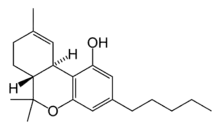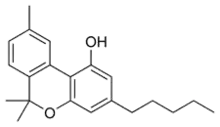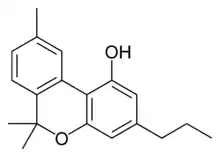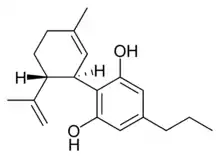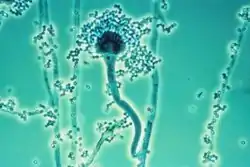Effects of cannabis
The effects of cannabis are caused by chemical compounds in the cannabis plant, including 113 different cannabinoids such as tetrahydrocannabinol (THC) and 120 terpenes,[1] which allow its drug to have various psychological and physiological effects on the human body. Different plants of the genus Cannabis contain different and often unpredictable concentrations of THC and other cannabinoids and hundreds of other molecules that have a pharmacological effect,[2][3] so the final net effect cannot reliably be foreseen.
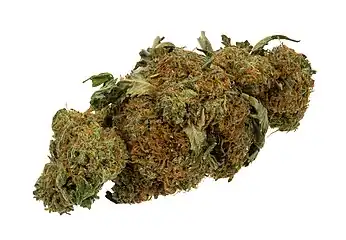
Acute effects while under the influence can sometimes include euphoria or anxiety.[4][5] Although some assert that cannabidiol (CBD), another cannabinoid found in cannabis in varying amounts, may alleviate the adverse effects of THC that some users experience,[6] little is known about CBD effects on humans.[7][8] Cannabinoid receptor antagonists have previously been tested as antidotes for cannabis intoxication with success, reducing or eliminating the physiological and psychological effects of intoxication.[9] Some of these products are currently in development as cannabis antidotes.
In the United States, medical cannabis research is limited by federal restrictions.[10] Smoking any substance could possibly carry similar risks as smoking tobacco due to carcinogens present in all smoke,[11][12][13] and the ultimate conclusions on these factors are disputed.[14][15][16][17]
Cannabis use disorder is defined as a medical diagnosis in the fifth revision of the Diagnostic and Statistical Manual of Mental Disorders (DSM-5).[18]
Chemistry
Cannabinoids and cannabinoid receptors
The most prevalent psychoactive substances in cannabis are cannabinoids, particularly THC. Some varieties, having undergone careful selection and growing techniques, can yield as much as 34% THC.[19] Another psychoactive cannabinoid present in Cannabis sativa is tetrahydrocannabivarin (THCV), but it is only found in small amounts and is a cannabinoid antagonist.[20]
There are similar compounds in cannabis that do not exhibit psychoactive response but are obligatory for functionality: cannabidiol (CBD), an isomer of THC; cannabivarin (CBV), an analog of cannabinol (CBN) with a different side chain, cannabidivarin (CBDV), an analog of CBD with a different side chain, and cannabinolic acid. CBD is believed to regulate the metabolism of THC by inactivating cytochrome P450 enzymes that metabolize drugs; one such mechanism is via generation of carbon monoxide (a pharmacologically active neurotransmitter) by upon metabolism of CBD.[21] THC is converted rapidly to 11-hydroxy-THC, which is also pharmacologically active, so the euphoria outlasts measurable THC levels in blood.[22]
Biochemical mechanisms in the brain
Cannabinoids usually contain a 1,1'-di-methyl-pyran ring, a variedly derivatized aromatic ring and a variedly unsaturated cyclohexyl ring and their immediate chemical precursors, constituting a family of about 60 bi-cyclic and tri-cyclic compounds. Like most other neurological processes, the effects of cannabis on the brain follow the standard protocol of signal transduction, the electrochemical system of sending signals through neurons for a biological response. It is now understood that cannabinoid receptors appear in similar forms in most vertebrates and invertebrates and have a long evolutionary history of 500 million years. The binding of cannabinoids to cannabinoid receptors decrease adenylyl cyclase activity, inhibit calcium N channels, and disinhibit K+A channels. There are at least two types of cannabinoid receptors (CB1 and CB2).[23]
Sustainability in the body
Most cannabinoids are lipophilic (fat soluble) compounds that are easily stored in fat, thus yielding a long elimination half-life relative to other recreational drugs. The THC molecule, and related compounds, are usually detectable in drug tests from 3 days up to 10 days according to Redwood Laboratories. Long-term users can produce positive tests for two to three months after ceasing cannabis use (see drug test).[24]
Toxicities
When cannabis is smoked, blood levels of THC peak rapidly after a few minutes and then decline, although the psychotropic effects persist for longer. Edible forms of cannabis often contain several hundred milligrams of THC, much more than the 32 mg of a typical cannabis cigarette. The rise of edible cannabis products has been responsible for a large increase of poisoning of children and young people: in American states which have legalized cannabis, emergency room admissions of such cases have typically doubled. Symptoms in children can include lethargy, sedation and seizure.[25]
Cannabis is suspected of being a potential contributory factor or direct cause of sudden death, due to the strain it can place on the cardiovascular system, or because of cannabinoid hyperemesis syndrome.[26]
Related to cannabinoids
THC, the principal psychoactive constituent of the cannabis plant, has an extremely low toxicity and the amount that can enter the body through the consumption of cannabis plants poses no threat of death. In dogs, the minimum lethal dose of THC is over 3000 mg/kg.[27] According to The Merck Index,[28] the LD50 of THC (the dose which causes the death of 50% of individuals) is 1270 mg/kg for male rats and 730 mg/kg for female rats from oral consumption in sesame oil, and 42 mg/kg for rats from inhalation.[29]
Cannabinoids and other molecules present in cannabis can alter the metabolism of other drugs, especially due to competition for clearing metabolic pathways such as cytochromes CYP450, thus leading to drug toxicities by medications that the person consuming cannabis may be taking.[30]
Related to smoking
A 2007 study found that while tobacco and cannabis smoke are quite similar, cannabis smoke contained higher amounts of ammonia, hydrogen cyanide, and nitrogen oxides, but lower levels of carcinogenic polycyclic aromatic hydrocarbons (PAHs).[31] This study found that directly inhaled cannabis smoke contained as much as 20 times as much ammonia and 5 times as much hydrogen cyanide as tobacco smoke and compared the properties of both mainstream and sidestream (smoke emitted from a smouldering 'joint' or 'cone') smoke.[31] Mainstream cannabis smoke was found to contain higher concentrations of selected polycyclic aromatic hydrocarbons (PAHs) than sidestream tobacco smoke.[31] However, other studies have found much lower disparities in ammonia and hydrogen cyanide between cannabis and tobacco, and that some other constituents (such as polonium-210, lead, arsenic, nicotine, and tobacco-specific nitrosamines) are either lower or non-existent in cannabis smoke.[32][33] A 2021 longitudinal study conducted among populations of HIV-positive and HIV-negative adults found that smoke-related carcinogenic toxicants and biomarkers detected in tobacco smokers were also detected in exclusive marijuana smokers, including carbon monoxide (CO), polycyclic aromatic hydrocarbons (PAHs), aldehydes (such as acrolein), acrylonitrile and acrylamide metabolites, but exposures are lower compared with tobacco or dual smokers.[34] Increased levels of acrolein exposure by tobacco smoking but not exclusive marijuana smoking were detected both in HIV-positive and HIV-negative adults, and contribute to increased diagnoses of cardiovascular diseases and respiratory diseases among tobacco smokers.[34]
Cannabis smoke contains thousands of organic and inorganic chemical compounds. This tar is chemically similar to that found in tobacco smoke or cigars.[35] Over fifty known carcinogens have been identified in cannabis smoke.[36] These include nitrosamines, reactive aldehydes, and polycylic hydrocarbons, including benz[a]pyrene.[37] Marijuana smoke was listed as a cancer agent in California in 2009.[38] A study by the British Lung Foundation published in 2012 identifies cannabis smoke as a carcinogen and also finds awareness of the danger is low compared with the high awareness of the dangers of smoking tobacco particularly among younger users. Other observations include possible increased risk from each cigarette; lack of research on the effect of cannabis smoke alone; low rate of addiction compared to tobacco; and episodic nature of cannabis use compared to steady frequent smoking of tobacco.[39] Professor David Nutt, a UK drug expert, points out that the study cited by the British Lung Foundation has been accused of both "false reasoning" and "incorrect methodology". Further, he notes that other studies have failed to connect cannabis with lung cancer, and accuses the BLF of "scaremongering over cannabis".[40]
Short-term effects
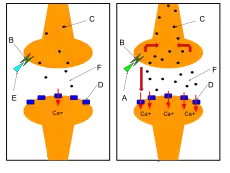
When smoked, the short-term effects of cannabis manifest within seconds and are fully apparent within a few minutes,[41] typically lasting for 1–3 hours, varying by the person and the strain of cannabis.[42] After oral ingestion of cannabis, the onset of effect is delayed relative to smoking, taking 30 minutes to 2 hours, but the duration is prolonged due to continued slow absorption.[41] The duration of noticeable effects has been observed to diminish after prolonged, repeated use and the development of increased tolerance to cannabinoids.[43]
Cannabis use can decrease blood pressure, which increases the risk of fainting.[44] Combining alcohol with cannabis greatly increases the level of impairment and the risk of injury or death from accidents.[45]
Psychological effects

The psychoactive effects of cannabis, known as a "high", are subjective and vary among persons and the method of use.
When THC enters the blood stream and reaches the brain, it binds to cannabinoid receptors. The endogenous ligand of these receptors is anandamide, the effects of which THC emulates. This agonism of the cannabinoid receptors results in changes in the levels of various neurotransmitters, especially dopamine and norepinephrine; neurotransmitters which are closely associated with the acute effects of cannabis ingestion, such as euphoria and anxiety. Some effects may include a general altered state of consciousness, euphoria, relaxation or stress reduction, increased appreciation of the arts, including humor and music, joviality, metacognition and introspection, enhanced recollection (episodic memory), and increased sensuality, sensory awareness, libido, and creativity.[46] Abstract or philosophical thinking, disruption of linear memory and paranoia or anxiety are also typical. Anxiety is the most commonly reported negative side effect of smoking marijuana. Up to 30 percent of recreational users experience intense anxiety and/or panic attacks after smoking cannabis. Some report anxiety only after not smoking cannabis for a prolonged period of time.[47] Inexperience and use in an unfamiliar environment are major contributing factors to this anxiety. Cannabidiol (CBD), another cannabinoid found in cannabis, has been shown to improve the adverse effects of THC, including anxiety.[48]
Cannabis produces many other subjective effects, including an increased enjoyment of food taste and aroma, and marked distortions in the perception of time. At higher doses, effects can include altered body image, auditory and/or visual illusions, pseudohallucinations, and ataxia from selective impairment of polysynaptic reflexes. In some cases, cannabis can lead to acute psychosis and dissociative states such as depersonalization[49][50] and derealization.[51]
Furthermore, even in those with no family history of psychosis, the administration of pure THC in clinical settings has been demonstrated to elicit transient psychotic symptoms.[52][53][54][55] Any episode of acute psychosis that accompanies cannabis use usually abates after six hours, but in rare instances, heavy users may find the symptoms continuing for many days.[56]
While psychoactive drugs are typically categorized as stimulants, depressants, or hallucinogens, cannabis exhibits a mix of all of these effects. Scientific studies have suggested that other cannabinoids like CBD may also play a significant role in its psychoactive effects.[57][58][59]
Somatic effects
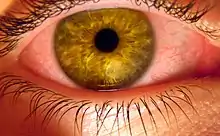
Some of the short-term physical effects of cannabis use include increased heart rate, dry mouth, reddening of the eyes (congestion of the conjunctival blood vessels), a reduction in intra-ocular pressure, muscle relaxation and a sensation of cold or hot hands and feet.[60]
Electroencephalography (EEG) shows somewhat more persistent alpha waves of slightly lower frequency than usual.[61] Cannabinoids produce a marked depression of motor activity via activation of neuronal cannabinoid receptors belonging to the Cannabinoid receptor type 1.[62]
Duration
Peak levels of cannabis-associated intoxication occur approximately 20 minutes after smoking it and last for several hours.[63] The total short-term duration of cannabis use when smoked depends on the potency, method of smoking – e.g. whether pure or in conjunction with tobacco – and how much is smoked. Peak levels of intoxication typically last an average of three to four hours.[63] When taken orally (in the form of capsules, food, or drink), the psychoactive effects take longer to manifest and generally last longer, typically lasting for an average of four to six hours after consumption.[64] Oral ingestion use eliminates the need to inhale toxic combustion products created by smoking and therefore negates the risk of respiratory harm associated with cannabis smoking.
Effects on driving
While several studies have shown increased risk associated with cannabis use by drivers, other studies have not found increased risk.[65] Cannabis usage has been shown in some studies to have a negative effect on driving ability.[66] The British Medical Journal indicated that "drivers who consume cannabis within three hours of driving are nearly twice as likely to cause a vehicle collision as those who are not under the influence of drugs or alcohol".[67]
In Cannabis and driving: a review of the literature and commentary, the United Kingdom's Department for Transport reviewed data on cannabis and driving, finding although impaired, "subjects under cannabis treatment appear to perceive that they are indeed impaired. Where they can compensate, they do".[68] In a review of driving simulator studies, researchers note that "even in those who learn to compensate for a drug's impairing effects, substantial impairment in performance can still be observed under conditions of general task performance (i.e. when no contingencies are present to maintain compensated performance)."[69]
A 2012 meta-analysis found that acute cannabis use increased the risk of an automobile crash.[70] An extensive 2013 review of 66 studies regarding crash risk and drug use found that cannabis was associated with minor, but not statistically significant increased odds of injury or fatal accident.[71]
In the largest and most precisely controlled study of its kind carried out by the U.S. Department of Transportation's National Highway Traffic Safety Administration, it was found that other "studies that measure the presence of THC in the drivers' blood or oral fluid, rather than relying on self-report tend to have much lower (or no) elevated crash risk estimates. Likewise better controlled studies have found lower (or no) elevated crash risk estimates".[65] The study found that "after adjusting for age, gender, race and alcohol use, drivers who tested positive for marijuana were no more likely to crash than those who had not used any drugs or alcohol prior to driving".[72] A 2018 study indicated that the number of fatal crashes involving marijuana after the recreational marijuana legalization or decriminalization increased in Colorado, Washington, and Massachusetts.[73]
Cardiovascular effects
Short-term (one to two hours) effects on the cardiovascular system can include increased heart rate, dilation of blood vessels, and fluctuations in blood pressure.[74][75][76] There are medical reports of occasional heart attacks or myocardial infarction, stroke and other cardiovascular side effects.[77] Marijuana's cardiovascular effects are not associated with serious health problems for most young, healthy users.[77] Researchers reported in the International Journal of Cardiology, "Marijuana use by older people, particularly those with some degree of coronary artery or cerebrovascular disease, poses greater risks due to the resulting increase in catecholamines, cardiac workload, and carboxyhemoglobin levels, and concurrent episodes of profound postural hypotension. Indeed, marijuana may be a much more common cause of myocardial infarction than is generally recognized. In day-to-day practice, a history of marijuana use is often not sought by many practitioners, and even when sought, the patient's response is not always truthful".[78]
A 2013 analysis of 3,886 myocardial infarction survivors over an 18-year period showed "no statistically significant association between marijuana use and mortality".[79]
A 2008 study by the National Institutes of Health Biomedical Research Centre in Baltimore found that heavy, chronic smoking of marijuana (138 joints per week) changed blood proteins associated with heart disease and stroke.[80]
A 2000 study by researchers at Boston's Beth Israel Deaconess Medical Center, Massachusetts General Hospital and Harvard School of Public Health found that a middle age person's risk of heart attack rises nearly fivefold in the first hour after smoking marijuana, "roughly the same risk seen within an hour of sexual activity".[81][82]
Cannabis arteritis is a very rare peripheral vascular disease similar to Buerger's disease. There were about 50 confirmed cases from 1960 to 2008, all of which occurred in Europe.[83]
Combination with other drugs
A confounding factor in cannabis research is the prevalent usage of other recreational drugs, especially alcohol and nicotine.[84] Such complications demonstrate the need for studies on cannabis that have stronger controls, and investigations into alleged symptoms of cannabis use that may also be caused by tobacco. Some critics question whether agencies doing the research make an honest effort to present an accurate, unbiased summary of the evidence, or whether they "cherry-pick" their data to please funding sources which may include the tobacco industry or governments dependent on cigarette tax revenue; others caution that the raw data, and not the final conclusions, are what should be examined.[85]
The Australian National Household Survey of 2001[86] showed that cannabis in Australia is rarely used without other drugs. 95% of cannabis users also drank alcohol; 26% took amphetamines; 19% took ecstasy and only 2.7% reported not having used any other drug with cannabis.[87] While research has been undertaken on the combined effects of alcohol and cannabis on performing certain tasks, little research has been conducted on the reasons why this combination is so popular. Evidence from a controlled experimental study undertaken by Lukas and Orozco[88] suggests that alcohol causes THC to be absorbed more rapidly into the blood plasma of the user. Data from the Australian National Survey of Mental Health and Wellbeing[89] found that three-quarters of recent cannabis users reported using alcohol when cannabis was not available, this suggests that the two are substitutes.[90]
Memory and learning
Studies on cannabis and memory are hindered by small sample sizes, confounding drug use, and other factors.[91] The strongest evidence regarding cannabis and memory focuses on its temporary negative effects on short-term and working memory.[91]
In a 2001 study looking at neuropsychological performance in long-term cannabis users, researchers found "some cognitive deficits appear detectable at least 7 days after heavy cannabis use but appear reversible and related to recent cannabis exposure rather than irreversible and related to cumulative lifetime use".[92] On his studies regarding cannabis use, lead researcher and Harvard professor Harrison Pope said he found marijuana is not dangerous over the long term, but there are short-term effects. From neuropsychological tests, Pope found that chronic cannabis users showed difficulties, with verbal memory in particular, for "at least a week or two" after they stopped smoking. Within 28 days, memory problems vanished and the subjects "were no longer distinguishable from the comparison group".[93] Researchers from the University of California, San Diego School of Medicine failed to show substantial, systemic neurological effects from long-term recreational use of cannabis. Their findings were published in the July 2003 issue of the Journal of the International Neuropsychological Society.[94] The research team, headed by Dr. Igor Grant, found that cannabis use did affect perception, but did not cause permanent brain damage. Researchers looked at data from 15 previously published controlled studies involving 704 long-term cannabis users and 484 nonusers. The results showed long-term cannabis use was only marginally harmful on memory and learning. Other functions such as reaction time, attention, language, reasoning ability, perceptual and motor skills were unaffected. The observed effects on memory and learning, they said, showed long-term cannabis use caused "selective memory defects", but that the impact was "of a very small magnitude".[95] A study by Johns Hopkins University School of Medicine showed that heavy use of marijuana is associated with decrements in neurocognitive performance even after 28 days of abstinence.[96]
Appetite
The feeling of increased appetite following the use of cannabis has been documented for hundreds of years,[97] and is known colloquially as the "munchies". Clinical studies and survey data have found that cannabis increases food enjoyment and interest in food.[98][99] A 2015 study suggests that cannabis triggers uncharacteristic behaviour in proopiomelanocortin (POMC) neurons, which are usually associated with decreasing hunger.[100][101]
Endogenous cannabinoids, more commonly known as endocannabinoids, exist in cow and human milk.[102][103][104][105][106][107][108] It is widely accepted that the neonatal survival of many species is largely dependent upon their suckling behavior and research has identified the endogenous cannabinoid system to be the first neural system to display complete control over milk ingestion and neonatal survival.[109][108]
Pathogens and microtoxins
Most microorganisms found in cannabis only affect plants and not humans, but some microorganisms, especially those that proliferate when the herb is not correctly dried and stored, can be harmful to humans. Some users may store marijuana in an airtight bag or jar in a refrigerator to prevent fungal and bacterial growth.[110]
The fungi Aspergillus flavus,[111] Aspergillus fumigatus,[111] Aspergillus niger,[111] Aspergillus parasiticus, Aspergillus tamarii, Aspergillus sulphureus, Aspergillus repens, Mucor hiemalis (not a human pathogen), Penicillium chrysogenum, Penicillium italicum and Rhizopus nigricans have been found in moldy cannabis.[110] Aspergillus mold species can infect the lungs via smoking or handling of infected cannabis and cause opportunistic and sometimes deadly aspergillosis.[112] Some of the microorganisms found create aflatoxins, which are toxic and carcinogenic. Mold is also found in smoke from mold-infected cannabis,[110][111] and the lungs and nasal passages are a major means of contracting fungal infections. Levitz and Diamond (1991) suggested baking marijuana in home ovens at 150 °C [302 °F], for five minutes before smoking. Oven treatment killed conidia of A. fumigatus, A. flavus and A. niger, and did not lower THC levels.[110] Cannabis contaminated with Salmonella muenchen was correlated with dozens of cases of salmonellosis in 1981.[113] Thermophilic actinomycetes were also found in cannabis.[111]
Long-term effects
Exposure to marijuana may have biologically based physical, mental, behavioral, and social health consequences and is "associated with diseases of the liver (particularly with co-existing hepatitis C), lungs, heart, eyesight, and vasculature" according to a 2013 literature review by Gordon and colleagues. The association with these diseases has only been reported in cases where people have smoked cannabis. The authors cautioned that "evidence is needed, and further research should be considered, to prove causal associations of marijuana with many physical health conditions".[114]
Cannabis use disorder is defined in the fifth revision of the Diagnostic and Statistical Manual of Mental Disorders (DSM-5) as a condition requiring treatment.[114] Several drugs have been investigated in an attempt to ameliorate the symptoms of stopping cannabis use. Such drugs include bupropion, divalproex, nefazodone, lofexidine, and dronabinol. Of these, dronabinol (a trade name for THC) has proven the most effective.[115] The drugs buspirone and rimonabant have shown some success in helping maintain cannabis abstinence.[116]
There is evidence that long-term use of cannabis increases the risk of psychosis, regardless of confounding factors, and particularly for people who have genetic risk factors.[117] A 2019 meta-analysis found that 34% of people with cannabis-induced psychosis transitioned to schizophrenia. This was found to be comparatively higher than hallucinogens (26%) and amphetamines (22%).[118]
Long-term cannabis users are at risk for developing cannabinoid hyperemesis syndrome (CHS), characterized by recurrent bouts of intense vomiting. The mechanism behind CHS is poorly understood and is contrary to the antiemetic properties of cannabis and cannabinoids. Of those who went to the emergency department (ED) with recurrent vomiting in one institution in the United States from 2005 to 2010, about 6% had the condition.[119][120]
Effects in pregnancy
Cannabis consumption in pregnancy might be associated with restrictions in growth of the fetus, miscarriage, and cognitive deficits in offspring based on animal studies, although there is limited evidence for this in humans at this time.[121] A 2012 systematic review found although it was difficult to draw firm conclusions, there was some evidence that prenatal exposure to cannabis was associated with "deficits in language, attention, areas of cognitive performance, and delinquent behavior in adolescence".[122] A report prepared for the Australian National Council on Drugs concluded cannabis and other cannabinoids are contraindicated in pregnancy as it may interact with the endocannabinoid system.[123]
Effects in pediatrics
Children can become exposed to cannabis, typically through accidental exposure which can lead to very high doses, especially in the case of edibles. Unlike in adults, these levels of exposure can lead to major complications in children.[124] These complications include encephalopathy, hypotension, respiratory depression severe enough to require ventilation, somnolence, coma, and in extreme cases, reports of death.[124][125][126] Pediatric exposure to edibles is of increasing concern because these products are typically sweets (gummies, cookies, etc.), and their prevalence is increasing as cannabis is legalized or decriminalized in many territories.[127]
See also
References
- Aizpurua-Olaizola O, Soydaner U, Öztürk E, Schibano D, Simsir Y, Navarro P, Etxebarria N, Usobiaga A (February 2016). "Evolution of the Cannabinoid and Terpene Content during the Growth of Cannabis sativa Plants from Different Chemotypes". Journal of Natural Products. 79 (2): 324–31. doi:10.1021/acs.jnatprod.5b00949. PMID 26836472. Archived from the original on 5 January 2023. Retrieved 24 November 2022.
- Rudolf Brenneisen. "Chemistry and Analysis of Phytocannabinoids and Other Cannabis Constituents" (PDF). Medicinalgenomics.com. Archived (PDF) from the original on 7 April 2018. Retrieved 9 April 2018.
- Atakan Z (December 2012). "Cannabis, a complex plant: different compounds and different effects on individuals". Therapeutic Advances in Psychopharmacology. 2 (6): 241–54. doi:10.1177/2045125312457586. PMC 3736954. PMID 23983983.
- Osborne GB, Fogel C (2008). "Understanding the motivations for recreational marijuana use among adult Canadians". Substance Use & Misuse. 43 (3–4): 539–72, discussion 573–9, 585–7. doi:10.1080/10826080701884911. PMID 18365950. S2CID 31053594.
- Ranganathan M, D'Souza DC (November 2006). "The acute effects of cannabinoids on memory in humans: a review". Psychopharmacology. 188 (4): 425–44. doi:10.1007/s00213-006-0508-y. PMID 17019571. S2CID 10328820.
- Grotenhermen F (2003). "Pharmacokinetics and pharmacodynamics of cannabinoids". Clinical Pharmacokinetics. 42 (4): 327–60. doi:10.2165/00003088-200342040-00003. PMID 12648025. S2CID 25623600.
- White CM (July 2019). "A Review of Human Studies Assessing Cannabidiol's (CBD) Therapeutic Actions and Potential". Journal of Clinical Pharmacology. 59 (7): 923–934. doi:10.1002/jcph.1387. PMID 30730563. S2CID 73452711.
- Haney M, Malcolm RJ, Babalonis S, Nuzzo PA, Cooper ZD, Bedi G, et al. (July 2016). "Oral Cannabidiol does not Alter the Subjective, Reinforcing or Cardiovascular Effects of Smoked Cannabis". Neuropsychopharmacology. 41 (8): 1974–82. doi:10.1038/npp.2015.367. PMC 4908634. PMID 26708108.
- Sabioni, Pamela; Le Foll, Bernard (2018). "Psychosocial and pharmacological interventions for the treatment of cannabis use disorder". F1000Research. 7: 173. doi:10.12688/f1000research.11191.1. ISSN 2046-1402. PMC 5811668. PMID 29497498.
- Borgelt LM, Franson KL, Nussbaum AM, Wang GS (February 2013). "The pharmacologic and clinical effects of medical cannabis". Pharmacotherapy (Review). 33 (2): 195–209. CiteSeerX 10.1.1.1017.1935. doi:10.1002/phar.1187. PMID 23386598. S2CID 8503107.
- Tomar, Rajpal C.; Beaumont and Hsieh (August 2009). "Evidence on the carcinogenicity of marijuana smoke" (PDF). Reproductive and Cancer Hazard Assessment Branch Office of Environmental Health Hazard Assessment, California Environmental Protection Agency. Archived (PDF) from the original on 24 July 2012. Retrieved 29 November 2018.
- Leweke FM, Koethe D (June 2008). "Cannabis and psychiatric disorders: it is not only addiction". Addiction Biology. 13 (2): 264–75. doi:10.1111/j.1369-1600.2008.00106.x. PMID 18482435. S2CID 205400285.
- Rubino T, Parolaro D (April 2008). "Long lasting consequences of cannabis exposure in adolescence". Molecular and Cellular Endocrinology (Submitted manuscript). 286 (1–2 Suppl 1): S108-13. doi:10.1016/j.mce.2008.02.003. PMID 18358595. S2CID 39245784. Archived from the original on 29 November 2018. Retrieved 28 August 2018.
- Michael Slezak (1 September 2009). "Doubt cast on cannabis, schizophrenia link". Abc.net.au. Archived from the original on 5 May 2019. Retrieved 8 January 2013.
- "Boston Municipal Courtcentral Division. Docket # 0701CR7229" (PDF). 2008. Archived (PDF) from the original on 29 August 2017. Retrieved 8 January 2013.
- DeLisi LE (March 2008). "The effect of cannabis on the brain: can it cause brain anomalies that lead to increased risk for schizophrenia?". Current Opinion in Psychiatry. 21 (2): 140–50. doi:10.1097/YCO.0b013e3282f51266. PMC 4337025. PMID 18332661.
- Denson TF, Earleywine M (April 2006). "Decreased depression in marijuana users". Addictive Behaviors. 31 (4): 738–42. doi:10.1016/j.addbeh.2005.05.052. PMID 15964704.
- Grohol, John M. (21 May 2013) Psy.D:DSM-5 Changes: Addiction, Substance-Related Disorders & Alcoholism Archived 11 December 2017 at the Wayback Machine. Pro.psychcentral.com. Retrieved on 19 December 2016.
- Escondido N (26 April 2017). "The Strongest Strains on Earth 2017". High Times. Archived from the original on 1 July 2018. Retrieved 30 June 2018.
- Turner CE, Bouwsma OJ, Billets S, Elsohly MA (June 1980). "Constituents of Cannabis sativa L. XVIII--Electron voltage selected ion monitoring study of cannabinoids". Biomedical Mass Spectrometry. 7 (6): 247–56. doi:10.1002/bms.1200070605. PMID 7426688.
- Hopper, Christopher P.; Zambrana, Paige N.; Goebel, Ulrich; Wollborn, Jakob (June 2021). "A brief history of carbon monoxide and its therapeutic origins". Nitric Oxide. 111–112: 45–63. doi:10.1016/j.niox.2021.04.001. PMID 33838343. S2CID 233205099. Archived from the original on 25 May 2021. Retrieved 23 April 2021.
- H.K. Kalant; W.H.E. Roschlau (1998). Principles of Medical Pharmacology (6th ed.). pp. 373–375.
- Pertwee RG (January 1997). "Pharmacology of cannabinoid CB1 and CB2 receptors". Pharmacology & Therapeutics. 74 (2): 129–80. doi:10.1016/S0163-7258(97)82001-3. PMID 9336020.
- "How long does cannabis stay in the body after smoking?". NHS. Archived from the original on 16 July 2015. Retrieved 4 August 2015.
- Blohm E, Sell P, Neavyn M (April 2019). "Cannabinoid toxicity in pediatrics". Curr Opin Pediatr. 31 (2): 256–261. doi:10.1097/MOP.0000000000000739. PMID 30694824. S2CID 59410966.
- Drummer OH, Gerostamoulos D, Woodford NW (May 2019). "Cannabis as a cause of death: A review". Forensic Sci Int. 298: 298–306. doi:10.1016/j.forsciint.2019.03.007. PMID 30925348. S2CID 87511682.
- Fitzgerald KT, Bronstein AC, Newquist KL (February 2013). "Marijuana poisoning". Topics in Companion Animal Medicine. 28 (1): 8–12. doi:10.1053/j.tcam.2013.03.004. PMID 23796481.
- 1996. The Merck Index, 12th ed., Merck & Co., Rahway, New Jersey
- "Cannabis Chemistry". Erowid.org. Archived from the original on 14 March 2007. Retrieved 29 July 2007.
- Zendulka, Ondřej; Dovrtělová, Gabriela; Nosková, Kristýna; Turjap, Miroslav; Šulcová, Alexandra; Hanuš, Lumír; Juřica, Jan (2016). "Cannabinoids and Cytochrome P450 Interactions". Current Drug Metabolism. 17 (3): 206–226. doi:10.2174/1389200217666151210142051. PMID 26651971.
- Moir D, Rickert WS, Levasseur G, Larose Y, Maertens R, White P, Desjardins S (February 2008). "A comparison of mainstream and sidestream marijuana and tobacco cigarette smoke produced under two machine smoking conditions". Chemical Research in Toxicology. 21 (2): 494–502. doi:10.1021/tx700275p. PMID 18062674.
- Institute of Medicine (1982). Marijuana and Health. Washington, D.C.: The National Academies Press. doi:10.17226/18942. ISBN 978-0-309-03236-0.
- Malmo-Levine, David (2 January 2002). "Radioactive Tobacco". acsa2000.net. Archived from the original on 12 January 2013.
- Lorenz, David R.; Misra, Vika; Chettimada, Sukrutha; Uno, Hajime; Wang, Lanqing; Blount, Benjamin C.; De Jesus, Victor R.; Gelman, Benjamin B.; Morgello, Susan; Wolinsky, Steven M.; Gabuzda, Dana (January 2021). "Acrolein and other toxicant exposures in relation to cardiovascular disease among marijuana and tobacco smokers in a longitudinal cohort of HIV-positive and negative adults" (PDF). eClinicalMedicine. Elsevier. 31 (100697): 100697. doi:10.1016/j.eclinm.2020.100697. PMC 7846668. PMID 33554087. S2CID 231802821. Archived from the original on 20 April 2023. Retrieved 7 September 2021.
- Hashibe M, Straif K, Tashkin DP, Morgenstern H, Greenland S, Zhang ZF (April 2005). "Epidemiologic review of marijuana use and cancer risk". Alcohol. 35 (3): 265–75. doi:10.1016/j.alcohol.2005.04.008. PMID 16054989.
- "Does smoking cannabis cause cancer?". Cancer Research UK. 20 September 2010. Archived from the original on 29 July 2012. Retrieved 23 June 2012.
{{cite journal}}: Cite journal requires|journal=(help) - Tashkin D (March 1997). "Effects of marijuana on the lung and its immune defenses". UCLA School of Medicine. Archived from the original on 23 June 2012. Retrieved 23 June 2012.
{{cite journal}}: Cite journal requires|journal=(help) - "Chemicals known to the state to cause cancer or reproductive toxicity" (PDF). ca.gov. 20 July 2012. Archived from the original (PDF) on 20 January 2013. Retrieved 8 January 2013.
- "The impact of cannabis on your lung". British Lung Association. June 2012. Archived from the original on 27 September 2013. Retrieved 8 January 2013.
{{cite journal}}: Cite journal requires|journal=(help) - Le B (8 June 2012). "Drug prof slams pot lung-danger claims". The Fix. Archived from the original on 30 December 2012. Retrieved 9 January 2013.
{{cite journal}}: Cite journal requires|journal=(help) - Ashton CH (February 2001). "Pharmacology and effects of cannabis: a brief review". The British Journal of Psychiatry. 178 (2): 101–6. doi:10.1192/bjp.178.2.101. PMID 11157422.
- "Cannabis". Dasc.sa.gov.au. Archived from the original on 27 March 2011. Retrieved 20 April 2011.
- Colizzi, Marco; Bhattacharyya, Sagnik (October 2018). "Cannabis use and the development of tolerance: a systematic review of human evidence". Neuroscience and Biobehavioral Reviews. 93: 1–25. doi:10.1016/j.neubiorev.2018.07.014. ISSN 1873-7528. PMID 30056176. S2CID 51718458. Archived from the original on 20 December 2022. Retrieved 20 December 2022.
- Canada, Health (2 March 2018). "Health effects of cannabis". www.canada.ca. Archived from the original on 17 November 2022. Retrieved 17 November 2022.
- "Health effects of cannabis" (PDF). Archived (PDF) from the original on 17 November 2022. Retrieved 17 November 2022.
- Osborne GB, Fogel C (2009). "Understanding the motivations for recreational marijuana use among adult Canadians" (PDF). Substance Use & Misuse. 43 (3–4): 539–72, discussion 573–9, 585–7. doi:10.1080/10826080701884911. PMID 18365950. S2CID 31053594. Archived (PDF) from the original on 3 March 2016.
- "Medical Marijuana and the Mind". Harvard Mental Health Letter. April 2010. Archived from the original on 16 January 2015. Retrieved 25 April 2011.
- Niesink RJ, van Laar MW (October 2013). "Does Cannabidiol Protect Against Adverse Psychological Effects of THC?". Frontiers in Psychiatry (Review). 4: 130. doi:10.3389/fpsyt.2013.00130. PMC 3797438. PMID 24137134.
- "Medication-Associated Depersonalization Symptoms". Medscape. Archived from the original on 14 February 2015. Retrieved 2 April 2009.
- Shufman E, Lerner A, Witztum E (April 2005). "[Depersonalization after withdrawal from cannabis usage]" (PDF). Harefuah (in Hebrew). 144 (4): 249–51, 303. PMID 15889607. Archived from the original (PDF) on 4 March 2011.
- Johnson BA (February 1990). "Psychopharmacological effects of cannabis". British Journal of Hospital Medicine. 43 (2): 114–6, 118–20, 122. PMID 2178712.
- D'Souza DC, Perry E, MacDougall L, Ammerman Y, Cooper T, Wu YT, et al. (August 2004). "The psychotomimetic effects of intravenous delta-9-tetrahydrocannabinol in healthy individuals: implications for psychosis". Neuropsychopharmacology. 29 (8): 1558–72. doi:10.1038/sj.npp.1300496. PMID 15173844. S2CID 12508404.
- Morrison PD, Nottage J, Stone JM, Bhattacharyya S, Tunstall N, Brenneisen R, et al. (March 2011). "Disruption of frontal θ coherence by Δ9-tetrahydrocannabinol is associated with positive psychotic symptoms". Neuropsychopharmacology. 36 (4): 827–36. doi:10.1038/npp.2010.222. PMC 3055738. PMID 21150914.
- Bhattacharyya S, Crippa JA, Allen P, Martin-Santos R, Borgwardt S, Fusar-Poli P, et al. (January 2012). "Induction of psychosis by Δ9-tetrahydrocannabinol reflects modulation of prefrontal and striatal function during attentional salience processing". Archives of General Psychiatry. 69 (1): 27–36. doi:10.1001/archgenpsychiatry.2011.161. PMID 22213786.
- Freeman D, Dunn G, Murray RM, Evans N, Lister R, Antley A, et al. (March 2015). "How cannabis causes paranoia: using the intravenous administration of ∆9-tetrahydrocannabinol (THC) to identify key cognitive mechanisms leading to paranoia". Schizophrenia Bulletin. 41 (2): 391–9. doi:10.1093/schbul/sbu098. PMC 4332941. PMID 25031222.
- Barceloux DG (20 March 2012). "Chapter 60: Marijuana (Cannabis sativa L.) and synthetic cannabinoids". Medical Toxicology of Drug Abuse: Synthesized Chemicals and Psychoactive Plants. John Wiley & Sons. p. 915. ISBN 978-0-471-72760-6.
- Stafford, Peter (1992). Psychedelics Encyclopedia. Berkeley, California, United States: Ronin Publishing, Inc. ISBN 978-0-914171-51-5.
- McKim, William A (2002). Drugs and Behavior: An Introduction to Behavioral Pharmacology (5 ed.). Prentice Hall. p. 400. ISBN 978-0-13-048118-4.
- "Information on Drugs of Abuse". Commonly Abused Drug Chart. nih.gov. 2 July 2018. Archived from the original on 29 December 2011. Retrieved 2 December 2013.
- Moelker W (19 September 2008). "How does Marijuana Affect Your Body? What are the Marijuana Physical Effects?". Archived from the original on 7 February 2009. Retrieved 22 January 2009.
- Kalant, H.K.; Roschlau, W.H.E. (1998). Principles of Medical Pharmacology (6th ed.). pp. 373–375.
- Andersson M, Usiello A, Borgkvist A, Pozzi L, Dominguez C, Fienberg AA, Svenningsson P, Fredholm BB, Borrelli E, Greengard P, Fisone G (September 2005). "Cannabinoid action depends on phosphorylation of dopamine- and cAMP-regulated phosphoprotein of 32 kDa at the protein kinase A site in striatal projection neurons". The Journal of Neuroscience. 25 (37): 8432–8. doi:10.1523/JNEUROSCI.1289-05.2005. PMC 6725667. PMID 16162925.
- Crean RD, Crane NA, Mason BJ (March 2011). "An evidence based review of acute and long-term effects of cannabis use on executive cognitive functions". Journal of Addiction Medicine. 5 (1): 1–8. doi:10.1097/ADM.0b013e31820c23fa. PMC 3037578. PMID 21321675.
- "Erowid Cannabis (Marijuana) Vault : Effects". Erowid.org. Archived from the original on 19 August 2016. Retrieved 9 April 2018.
- Compton R, Berning A (February 2015). "Drug and Alcohol Crash Risk" (PDF). Traffic Safety Facts. Archived from the original (PDF) on 9 August 2018. Retrieved 13 February 2015.
- Li MC, Brady JE, DiMaggio CJ, Lusardi AR, Tzong KY, Li G (2012). "Marijuana use and motor vehicle crashes". Epidemiologic Reviews. 34 (1): 65–72. doi:10.1093/epirev/mxr017. PMC 3276316. PMID 21976636.
- Asbridge M, Hayden JA, Cartwright JL (February 2012). "Acute cannabis consumption and motor vehicle collision risk: systematic review of observational studies and meta-analysis". BMJ. 344: e536. doi:10.1136/bmj.e536. PMC 3277079. PMID 22323502.
- Department For Transport, Great Minster House. "Cannabis and driving: a review of the literature and commentary (No.12)". Department of Transport. UK Government. Archived from the original on 9 February 2010. Retrieved 19 December 2016.
- European Monitoring Centre for Drugs Drug Addiction (June 2008). Sznitman SR, Olsson B, Room R (eds.). A cannabis reader: global issues and local experiences. Vol. 2. Lisbon: European Monitoring Centre for Drugs and Drug Addiction. doi:10.2810/13807. ISBN 978-92-9168-312-3.
- Asbridge M, Hayden JA, Cartwright JL (February 2012). "Acute cannabis consumption and motor vehicle collision risk: systematic review of observational studies and meta-analysis". BMJ. 344 (feb09 2): e536. doi:10.1136/bmj.e536. PMC 3277079. PMID 22323502.
- Elvik R (November 2013). "Risk of road accident associated with the use of drugs: a systematic review and meta-analysis of evidence from epidemiological studies". Accident Analysis and Prevention. 60: 254–67. doi:10.1016/j.aap.2012.06.017. PMID 22785089.
- Ingraham, C (9 February 2015). "Stoned drivers are a lot safer than drunk ones, new federal data show". Washington Post. Archived from the original on 13 February 2015. Retrieved 13 February 2015.
- Lee J, Abdel-Aty A, Park J (May 2018). "Investigation of associations between marijuana law changes and marijuana-involved fatal traffic crashes: A state-level analysis". Journal of Transport & Health. 10: 194–202. doi:10.1016/j.jth.2018.05.017. S2CID 159774424.
- Falvo, D R (2005). Medical and psychosocial aspects of chronic illness and disability (Third ed.). Jones & Bartlett Learning. p. 217. ISBN 978-0-7637-3166-3.
- Ghodse, Hamid (2010). Ghodse's Drugs and Addictive Behaviour. Cambridge University Press. p. 97. ISBN 978-1-139-48567-8.
- Jones RT (November 2002). "Cardiovascular system effects of marijuana". Journal of Clinical Pharmacology. 42 (S1): 58S–63S. doi:10.1002/j.1552-4604.2002.tb06004.x. PMID 12412837. S2CID 12193532.
- Jones RT (November 2002). "Cardiovascular system effects of marijuana". Journal of Clinical Pharmacology. 42 (S1): 58S–63S. doi:10.1002/j.1552-4604.2002.tb06004.x. PMID 12412837. S2CID 12193532.
- Aryana A, Williams MA (May 2007). "Marijuana as a trigger of cardiovascular events: speculation or scientific certainty?". International Journal of Cardiology. 118 (2): 141–4. doi:10.1016/j.ijcard.2006.08.001. PMID 17005273. Archived from the original on 17 April 2018. Retrieved 6 April 2013.
- Frost L, Mostofsky E, Rosenbloom JI, Mukamal KJ, Mittleman MA (February 2013). "Marijuana use and long-term mortality among survivors of acute myocardial infarction". American Heart Journal. 165 (2): 170–5. doi:10.1016/j.ahj.2012.11.007. PMC 3558923. PMID 23351819.
- "Heavy pot smoking could raise risk of heart attack, stroke". CBC. 13 May 2008. Archived from the original on 10 November 2012. Retrieved 17 April 2009.
- "Marijuana Linked to Increased Stroke Risk". Time. 8 February 2013. Archived from the original on 20 April 2023. Retrieved 19 May 2013.
- Noble HB (3 March 2000). "Report Links Heart Attacks To Marijuana". The New York Times. Archived from the original on 7 August 2009. Retrieved 26 April 2009.
- Peyrot I, Garsaud AM, Saint-Cyr I, Quitman O, Sanchez B, Quist D (March 2007). "Cannabis arteritis: a new case report and a review of literature". Journal of the European Academy of Dermatology and Venereology. 21 (3): 388–91. doi:10.1111/j.1468-3083.2006.01947.x. PMID 17309465. S2CID 43529847.
Amputation of the right second toe and of the left leg finally became necessary.
- Zhang ZF, Morgenstern H, Spitz MR, Tashkin DP, Yu GP, Marshall JR, Hsu TC, Schantz SP (December 1999). "Marijuana use and increased risk of squamous cell carcinoma of the head and neck". Cancer Epidemiology, Biomarkers & Prevention. 8 (12): 1071–8. PMID 10613339. Archived from the original on 23 February 2013. Retrieved 27 January 2011.
- "Public opinion on drugs and drug policy". Fact Research Guide. Easton Business Centre, Felix Rd., Bristol, UK.: Transform Drug Policy Foundation. Archived from the original on 15 July 2014. Retrieved 24 March 2007.
Data is notoriously easy to cherry pick or spin to support a particular agenda or position. Often the raw data will conceal all sorts of interesting facts that the headlines have missed.
- "2001 National Drug Strategy Household Survey: detailed findings". Australian Institute of Health and Welfare. 19 December 2002. Archived from the original on 21 February 2011. Retrieved 1 February 2011. AIHW cat no. PHE 41.
- "2001 National Drug Steategy Household Survey: first results". Australian Institute of Health and Welfare. 20 May 2002. Archived from the original on 21 February 2011. Retrieved 1 February 2011. AIHW cat no. PHE 35.
- Lukas SE, Orozco S (October 2001). "Ethanol increases plasma Delta(9)-tetrahydrocannabinol (THC) levels and subjective effects after marihuana smoking in human volunteers". Drug and Alcohol Dependence. 64 (2): 143–9. doi:10.1016/S0376-8716(01)00118-1. PMID 11543984.
- Kee, Carol (August 1998). National Survey of Mental Health and Wellbeing of Adults 1997. ACT Department of Health and Community Care. Archived from the original on 14 March 2011. Retrieved 1 February 2011.
- Degenhardt L, Hall W (August 2001). "The relationship between tobacco use, substance-use disorders and mental health: results from the National Survey of Mental Health and Well-being". Nicotine & Tobacco Research. 3 (3): 225–34. doi:10.1080/14622200110050457. PMID 11506766.
- Riedel G, Davies SN (2005). "Cannabinoid function in learning, memory and plasticity". Cannabinoids. Handbook of Experimental Pharmacology. Vol. 168. pp. 445–77. doi:10.1007/3-540-26573-2_15. ISBN 978-3-540-22565-2. PMID 16596784.
- Pope HG, Gruber AJ, Hudson JI, Huestis MA, Yurgelun-Todd D (October 2001). "Neuropsychological performance in long-term cannabis users". Archives of General Psychiatry. 58 (10): 909–15. doi:10.1001/archpsyc.58.10.909. PMID 11576028.
- Lyons, Casey (October 2012) "Lost in the Weeds: Legalizing Medical Marijuana in Massachusetts" Archived 24 October 2014 at the Wayback Machine. Boston.
- Minimal Long-Term Effects of Marijuana Use Found. Journal of the International Neuropsychological Society (27 June 2003)
- Beasley, Deena (27 June 2003) Study – Pot doesn't cause permanent brain damage. Reuters Health E-Line
- Bolla KI, Brown K, Eldreth D, Tate K, Cadet JL (November 2002). "Dose-related neurocognitive effects of marijuana use". Neurology. 59 (9): 1337–43. doi:10.1212/01.WNL.0000031422.66442.49. PMID 12427880. S2CID 11525660.
- Mechoulam R (1984). Cannabinoids as therapeutic agents. Boca Raton, FL: CRC Press. ISBN 978-0-8493-5772-5.
- Ad Hoc Group of Experts. "Workshop on the Medical Utility of Marijuana". Report to the Director, Institute of Medicine. U.S. National Institutes of Health. Archived from the original on 3 November 2007.
- Bonsor, Kevin. "How Marijauan Works: Other Physiological Effects Archived 11 August 2007 at the Wayback Machine". HowStuffWorks. Retrieved on 3 November 2007
- Devlin H (18 February 2015). "Cannabis 'munchies' explained by new research". The Guardian. Archived from the original on 18 October 2018. Retrieved 18 October 2018.
- Koch M, Varela L, Kim JG, Kim JD, Hernández-Nuño F, Simonds SE, Castorena CM, Vianna CR, Elmquist JK, Morozov YM, Rakic P, Bechmann I, Cowley MA, Szigeti-Buck K, Dietrich MO, Gao XB, Diano S, Horvath TL (March 2015). "Hypothalamic POMC neurons promote cannabinoid-induced feeding". Nature. 519 (7541): 45–50. Bibcode:2015Natur.519...45K. doi:10.1038/nature14260. PMC 4496586. PMID 25707796.
- Di Marzo V, Sepe N, De Petrocellis L, Berger A, Crozier G, Fride E, Mechoulam R (December 1998). "Trick or treat from food endocannabinoids?". Nature. 396 (6712): 636–7. Bibcode:1998Natur.396..636D. doi:10.1038/25267. PMID 9872309. S2CID 4425760. Archived from the original on 20 April 2023. Retrieved 27 August 2020.
- di Tomaso E, Beltramo M, Piomelli D (August 1996). "Brain cannabinoids in chocolate". Nature (Submitted manuscript). 382 (6593): 677–8. Bibcode:1996Natur.382..677D. doi:10.1038/382677a0. PMID 8751435. S2CID 4325706. Archived from the original on 19 October 2018. Retrieved 28 August 2018.
- Fride E, Bregman T, Kirkham TC (April 2005). "Endocannabinoids and food intake: newborn suckling and appetite regulation in adulthood" (PDF). Experimental Biology and Medicine. 230 (4): 225–34. doi:10.1177/153537020523000401. PMID 15792943. S2CID 25430588. Archived (PDF) from the original on 2 August 2009. Retrieved 20 June 2017.
- The Endocannabinoid-CB Receptor System: Importance for development and in pediatric disease Archived 2 April 2016 at the Wayback Machine Neuroendocrinology Letters Nos.1/2, Feb-Apr Vol.25, 2004.
- Cannabinoids and Feeding: The Role of the Endogenous Cannabinoid System as a Trigger for Newborn Suckling Archived 1 October 2020 at the Wayback Machine Women and Cannabis: Medicine, Science, and Sociology, 2002 The Haworth Press, Inc.
- Wu J, Gouveia-Figueira S, Domellöf M, Zivkovic AM, Nording ML (January 2016). "Oxylipins, endocannabinoids, and related compounds in human milk: Levels and effects of storage conditions". Prostaglandins & Other Lipid Mediators. 122: 28–36. doi:10.1016/j.prostaglandins.2015.11.002. PMID 26656029.
- Fride E (October 2004). "The endocannabinoid-CB(1) receptor system in pre- and postnatal life". European Journal of Pharmacology. 500 (1–3): 289–97. doi:10.1016/j.ejphar.2004.07.033. PMID 15464041.
- "NCPIC Research Briefs • NCPIC". Ncpic.org.au. 11 March 2011. Archived from the original on 6 July 2011. Retrieved 20 April 2011.
{{cite web}}: CS1 maint: unfit URL (link) - "Microbiological contaminants of marijuana". www.hempfood.com. Archived from the original on 11 July 2011. Retrieved 22 June 2008.
- Kagen SL, Kurup VP, Sohnle PG, Fink JN (April 1983). "Marijuana smoking and fungal sensitization". The Journal of Allergy and Clinical Immunology. 71 (4): 389–93. doi:10.1016/0091-6749(83)90067-2. PMID 6833678.
- Remington TL, Fuller J, Chiu I (November 2015). "Chronic necrotizing pulmonary aspergillosis in a patient with diabetes and marijuana use". CMAJ. 187 (17): 1305–8. doi:10.1503/cmaj.141412. PMC 4646751. PMID 26100839.
- Taylor DN, Wachsmuth IK, Shangkuan YH, Schmidt EV, Barrett TJ, Schrader JS, Scherach CS, McGee HB, Feldman RA, Brenner DJ (May 1982). "Salmonellosis associated with marijuana: a multistate outbreak traced by plasmid fingerprinting". The New England Journal of Medicine. 306 (21): 1249–53. doi:10.1056/NEJM198205273062101. PMID 7070444.
- Gordon AJ, Conley JW, Gordon JM (December 2013). "Medical consequences of marijuana use: a review of current literature". Current Psychiatry Reports (Submitted manuscript). 15 (12): 419. doi:10.1007/s11920-013-0419-7. PMID 24234874. S2CID 29063282. Archived from the original on 7 August 2019. Retrieved 28 August 2018.
- Vandrey R, Haney M (2009). "Pharmacotherapy for cannabis dependence: how close are we?". CNS Drugs (Review). 23 (7): 543–53. doi:10.2165/00023210-200923070-00001. PMC 2729499. PMID 19552483.
- Benyamina, Amine; Lecacheux, Marie; Blecha, Lisa; Reynaud, Michel; Lukasiewcz, Michael (1 March 2008). "Pharmacotherapy and psychotherapy in cannabis withdrawal and dependence". Expert Review of Neurotherapeutics. 8 (3): 479–491. doi:10.1586/14737175.8.3.479. ISSN 1473-7175. PMID 18345976. S2CID 207194905.
- Steenkamp MM, Blessing EM, Galatzer-Levy IR, Hollahan LC, Anderson WT (March 2017). "Marijuana and other cannabinoids as a treatment for posttraumatic stress disorder: A literature review". Depression and Anxiety. 34 (3): 207–216. doi:10.1002/da.22596. PMID 28245077. S2CID 205737272.
- Murrie, Benjamin; Lappin, Julia; Large, Matthew; Sara, Grant (16 October 2019). "Transition of Substance-Induced, Brief, and Atypical Psychoses to Schizophrenia: A Systematic Review and Meta-analysis". Schizophrenia Bulletin. 46 (3): 505–516. doi:10.1093/schbul/sbz102. PMC 7147575. PMID 31618428.
- Simonetto, Douglas A.; Oxentenko, Amy S.; Herman, Margot L.; Szostek, Jason H. (2012). "Cannabinoid Hyperemesis: A Case Series of 98 Patients". Mayo Clinic Proceedings. 87 (2): 114–119. doi:10.1016/j.mayocp.2011.10.005. ISSN 0025-6196. PMC 3538402. PMID 22305024.
- Chocron, Yaniv; Zuber, Jean-Philippe; Vaucher, Julien (2019). "Cannabinoid hyperemesis syndrome". BMJ. 366: l4336. doi:10.1136/bmj.l4336. ISSN 0959-8138. PMID 31324702. S2CID 198133206.
- Fonseca BM, Correia-da-Silva G, Almada M, Costa MA, Teixeira NA (2013). "The Endocannabinoid System in the Postimplantation Period: A Role during Decidualization and Placentation". International Journal of Endocrinology (Review). 2013: 1–11. doi:10.1155/2013/510540. PMC 3818851. PMID 24228028.
- Irner TB (2012). "Substance exposure in utero and developmental consequences in adolescence: a systematic review". Child Neuropsychology (Review). 18 (6): 521–49. doi:10.1080/09297049.2011.628309. PMID 22114955. S2CID 25014303.
- Copeland J, Gerber S, Swift W (2006). Evidence-based answers to cannabis questions: a review of the literature. Canberra: Australian National Council on Drugs. ISBN 978-1-877018-12-1.
- Wong, Kei U.; Baum, Carl R. (November 2019). "Acute Cannabis Toxicity". Pediatric Emergency Care. 35 (11): 799–804. doi:10.1097/PEC.0000000000001970. ISSN 0749-5161. PMID 31688799. S2CID 207897219. Archived from the original on 20 April 2023. Retrieved 27 October 2021.
- Nappe, Thomas M.; Hoyte, Christopher O. (16 March 2017). "Pediatric Death Due to Myocarditis After Exposure to Cannabis". Clinical Practice and Cases in Emergency Medicine. 1 (3): 166–170. doi:10.5811/cpcem.2017.1.33240. ISSN 2474-252X. PMC 5965161. PMID 29849306.
- Claudet, Isabelle; Le Breton, Mathilde; Bréhin, Camille; Franchitto, Nicolas (April 2017). "A 10-year review of cannabis exposure in children under 3-years of age: do we need a more global approach?". European Journal of Pediatrics. 176 (4): 553–556. doi:10.1007/s00431-017-2872-5. ISSN 1432-1076. PMID 28210835. S2CID 11639790. Archived from the original on 29 July 2021. Retrieved 29 July 2021.
- Wang, George S.; Roosevelt, Genie; Le Lait, Marie-Claire; Martinez, Erin M.; Bucher-Bartelson, Becki; Bronstein, Alvin C.; Heard, Kennon (1 June 2014). "Association of Unintentional Pediatric Exposures With Decriminalization of Marijuana in the United States". Annals of Emergency Medicine. 63 (6): 684–689. doi:10.1016/j.annemergmed.2014.01.017. ISSN 0196-0644. PMID 24507243. Archived from the original on 29 July 2021. Retrieved 29 July 2021.
Further reading
- National Academies of Sciences, Engineering, and Medicine (2017). The Health Effects of Cannabis and Cannabinoids: The Current State of Evidence and Recommendations for Research. doi:10.17226/24625. ISBN 978-0-309-45304-2. PMID 28182367.
{{cite book}}:|website=ignored (help)CS1 maint: multiple names: authors list (link)
